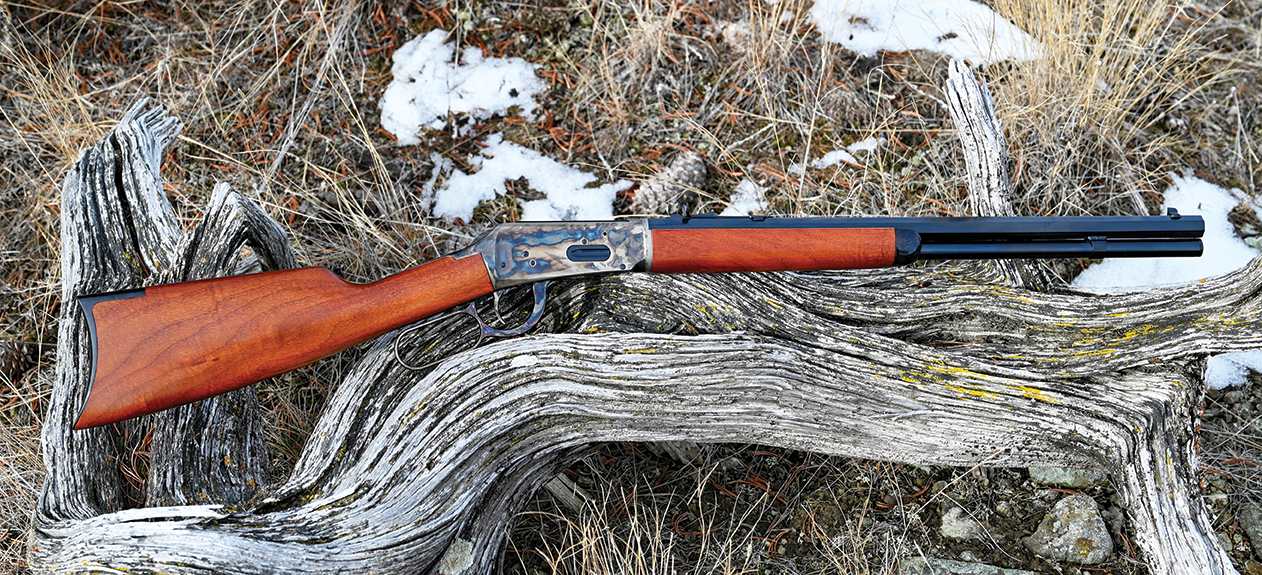
The Cimarron 1894 Short Rifle.
For many years we have noticed the excellent quality firearms marketed by
Cimarron Firearms Company. Mike Harvey, Cimarron’s president, has been in business with his company since 1984. Focused on providing finely finished reproduction firearms of the Old West, Mike has brought his love of antique rifles, pistols and shotguns to the marketplace. Cimarron firearms show closer attention to original specifications and detail along with excellent fit and polish. Many of the guns that Cimarron markets are copies of firearms that would simply be beyond the reach of average enthusiasts, and offer a viable alternative to those of us who actually want to use our guns. Made from modern steels, the Cimarron line of firearms also alleviates the safety concerns that come with shooting many old originals.
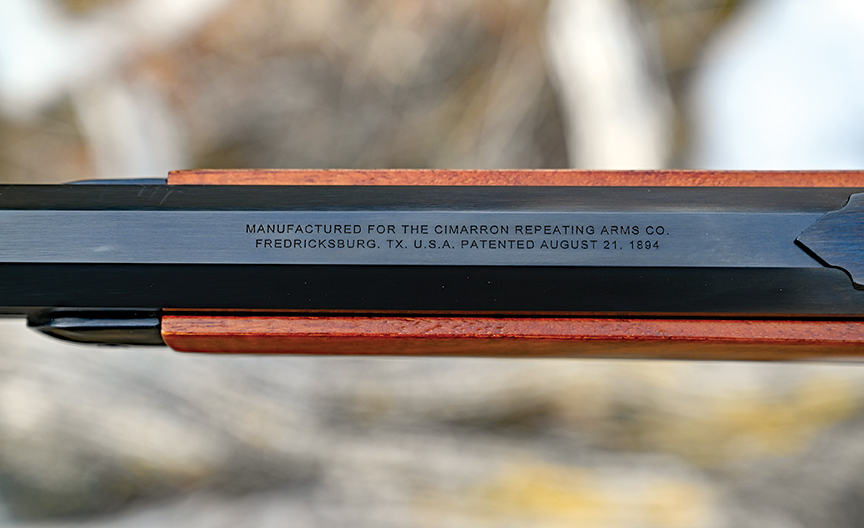
Cimarron barrel stamping on the Model 1894 38-55.
We contacted Cimarron about writing an article on one of their firearms and shortly after we received one of their new Model 1894 rifles. The gun was in “Short Rifle” configuration and chambered in 38-55. I doubt if there is a more universally recognized lever action rifle than the Winchester ’94, even among non-gun owners. The 20-inch barreled 1894 Short Rifle has always been a favorite of mine, as it retains the handiness of the 20-inch carbine but with the nice balance of the long-barreled rifle. With the price of original Winchester 1894s going ever upward, especially those in rare configurations, the Cimarron 1894 represents an affordable option for someone who wants to use the rifle in the field.
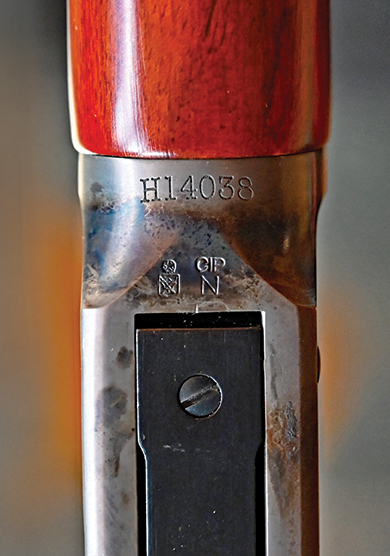
The rifle’s proof marks are in a tasteful, unobtrusive location.
Upon receiving the Cimarron rifle, we took it to the shop to give it a thorough look-over. The fit and finish immediately impressed me, especially with the location of the European proof-marks in a very unobtrusive location. Some imported firearms have their many proof marks in obnoxious locations and look like they were struck in with a 10-pound hammer. I also liked the way that the top barrel flat was marked with Cimarron’s name and caliber designations, which is very reminiscent of original production in style and location. Nothing turns me off quicker with an old-style firearm than modern, redundant barrel markings or warnings.

Excellent wood-to-metal fit and attractive case colored receiver.
Wood to metal fit on the Cimarron was excellent, as was the bluing and casehardening. The casehardening didn’t have the harshness that we have come to expect on reproduction firearms but had a pleasing muted look, with a majority of blues and greys. The tight-grained stock looked to be European walnut, stained to a pleasing “Winchester” red, the grain filled and finished with a low gloss finish. The buttplate and forearm cap were finished in a pleasing deep blue, matching the barrel. The blued buttplate, barrel, loading gate, breech bolt, link and forend cap all showed proper polishing prior to the bluing process, no waves or scratches that would be a sure sign of a substandard job of polishing. The metal finish on the Cimarron 1894 was exemplary in this regard and the blued parts made a pleasing contrast to the casehardened receiver.
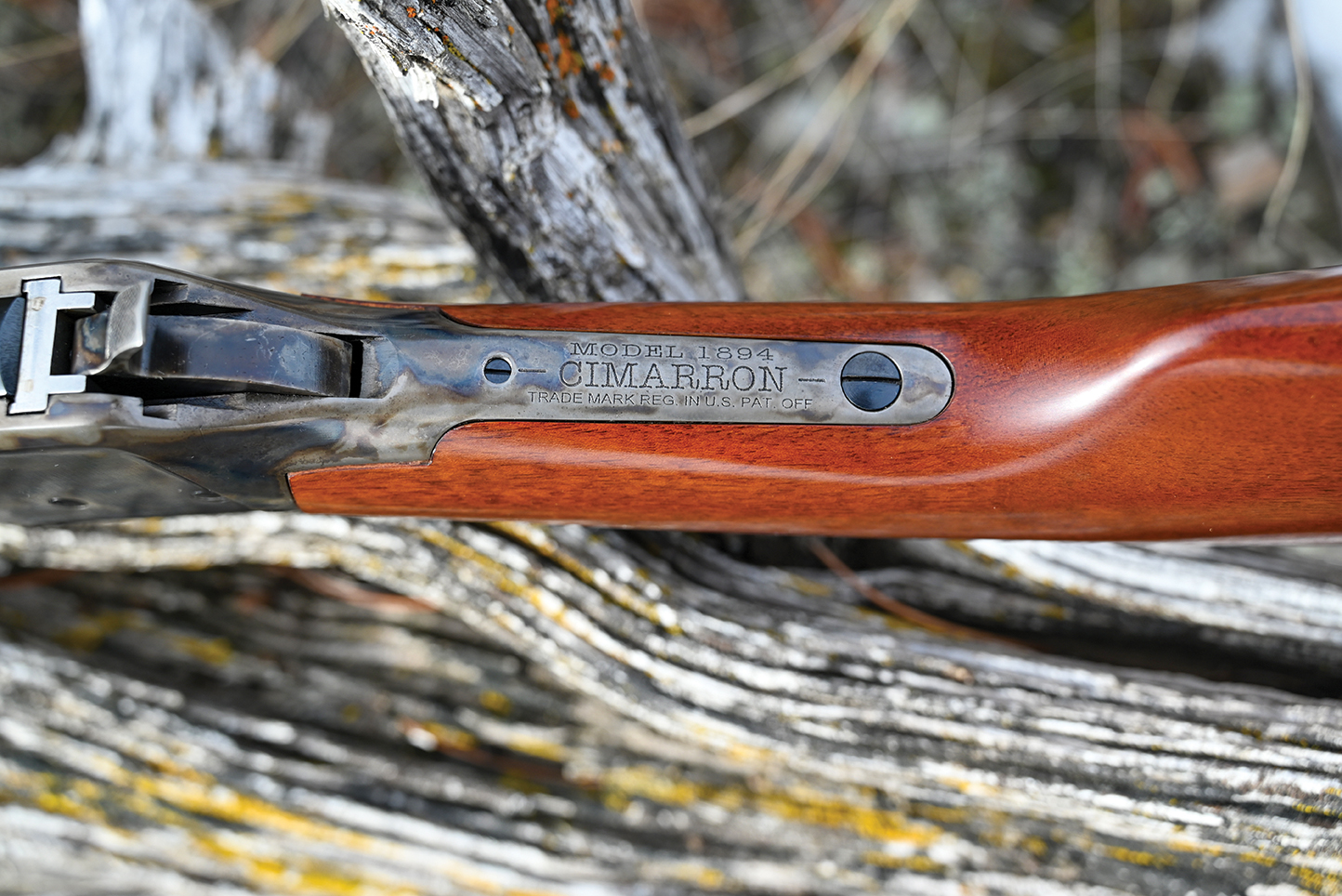
Cimarron marking on top receiver tang.
The rifling looked to be broach-cut under the scrutiny of the bore scope and when the barrel was slugged I could not detect any serious tight or loose places; the bore felt very uniform from breech to muzzle with a one in 18 twist. The rifling was .0035 deep with a .373 and .380 bore and groove measurement, respectively. I had high hopes that the rifle would be a good shooter with the proper size cast bullets.
The rifle came equipped with a standard buckhorn rear sight and .060 thick blade front sight. Both of the sights were very close in design to original Winchester production, using a small screw to lock them in the dovetail. I wanted to use a tang sight to increase iron sight accuracy potential and so mounted an original Marbles tang sight on the top tang. An interesting note; the hole spacing on the top tang was to original production spec, so any tang sight made with Winchester spacing will fit. This a nice touch that is many times overlooked on reproduction rifles.
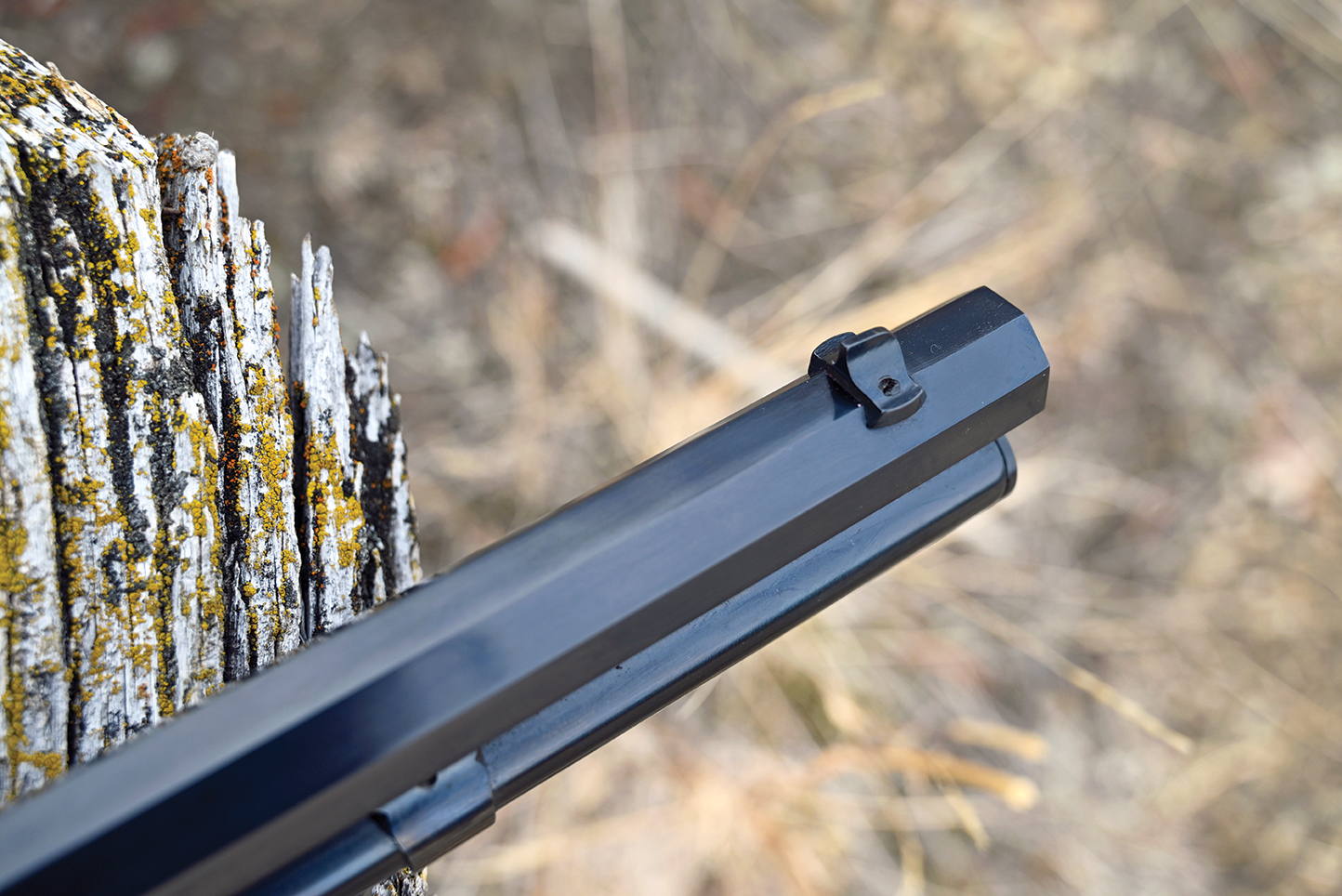
The Winchester-style front sight with locking screw.
The trigger pull, as it came from Cimarron was right at 5.5 pounds, a little heavy for my taste, but clean with no creep and no excessive over-travel. Once I became acquainted with the trigger, it was very easy to control consistently. My only criticism in this area was I felt the hammer spring to be a bit light, but subsequent shooting showed that it was more than enough to provide reliable ignition of the primers. The lighter hammer fall contributed the smoothness of the action, which was easy to cycle with no hang-ups or rough spots.
I wanted to test this rifle with black powder because, well…this is a black powder magazine. Also, getting a 38-55 to shoot with smokeless is no big trick, but black powder can be a little more difficult. If a rifle will shoot black powder accurately it has been my experience that smokeless presents much less of a challenge.
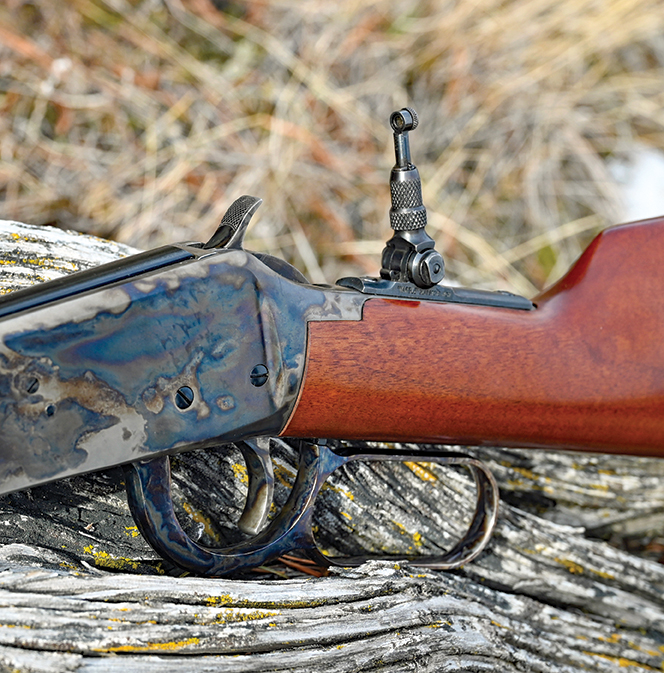
The Cimarron 1894 with vintage Marbles tang sight.
First, the rifle was checked for reliability of function. I cycled several types of ammunition through the action with no hang-ups or failures to feed, including cycling the rifle with the muzzle raised. This is always a test I perform on Model 1894 rifles, as I once lost a nice whitetail buck to a jammed ’94 carbine when I attempted to chamber a round with the muzzle almost straight up.
For accuracy tests I used a favorite load consisting of 42 grains of 1½ Fg Swiss powder, a .030 Walters Wad and a Brooks 300-grain flat-nose, plain-base bullet, cast 1-20, sized to .380 and lubed with SPG Lube. Remington Large Pistol primers were used in the Winchester cases and overall length was 2.480. This heavy .38 bullet seats deep in the case and will still function through a lever action.
We shot four, five-shot targets at 100 yards with the rifle because I wanted to get a 20-shot average for accuracy. I fired the rifle single shot, used a blow tube between rounds but did not clean between the five-shot groups. The afore-mentioned Marbles tang sight was used and the factory blade front sight. The rifle was set up in a benchrest situation with a Kearns front rest and a sand bag rear. Target One measured 1.780 on farthest shots, which included the high clean-barrel fouling shot. Target Two went 2.926 with the shots strung horizontally from a right to left wind. Target Three measured 2.397 on farthest bullet holes and Target Four came in at 2.730 measured on widest holes. The wind was light and somewhat unpredictable; as one can see from the targets, it did add to the horizontal group size. Average for the 20 shots was 2.338, and I felt the rifle made a good showing. Recoil was pleasant, even with the 300–grain bullets, due to the heavier octagon barrel. Winchester carbines in 38-55 with the light round barrel can sometimes be surprising with their vigorous recoil. The Cimarron “Short Rifle” weighed exactly seven pounds (empty) and carried enough extra weight at the muzzle to dampen recoil nicely.
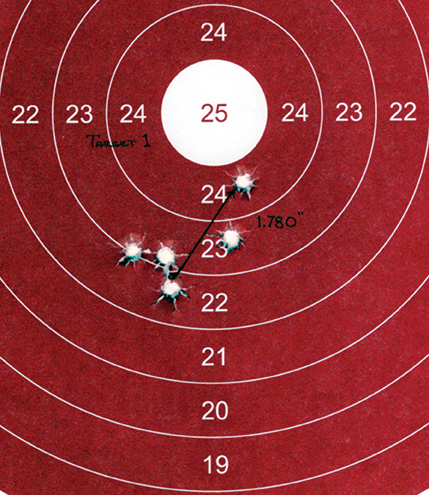
Target 1
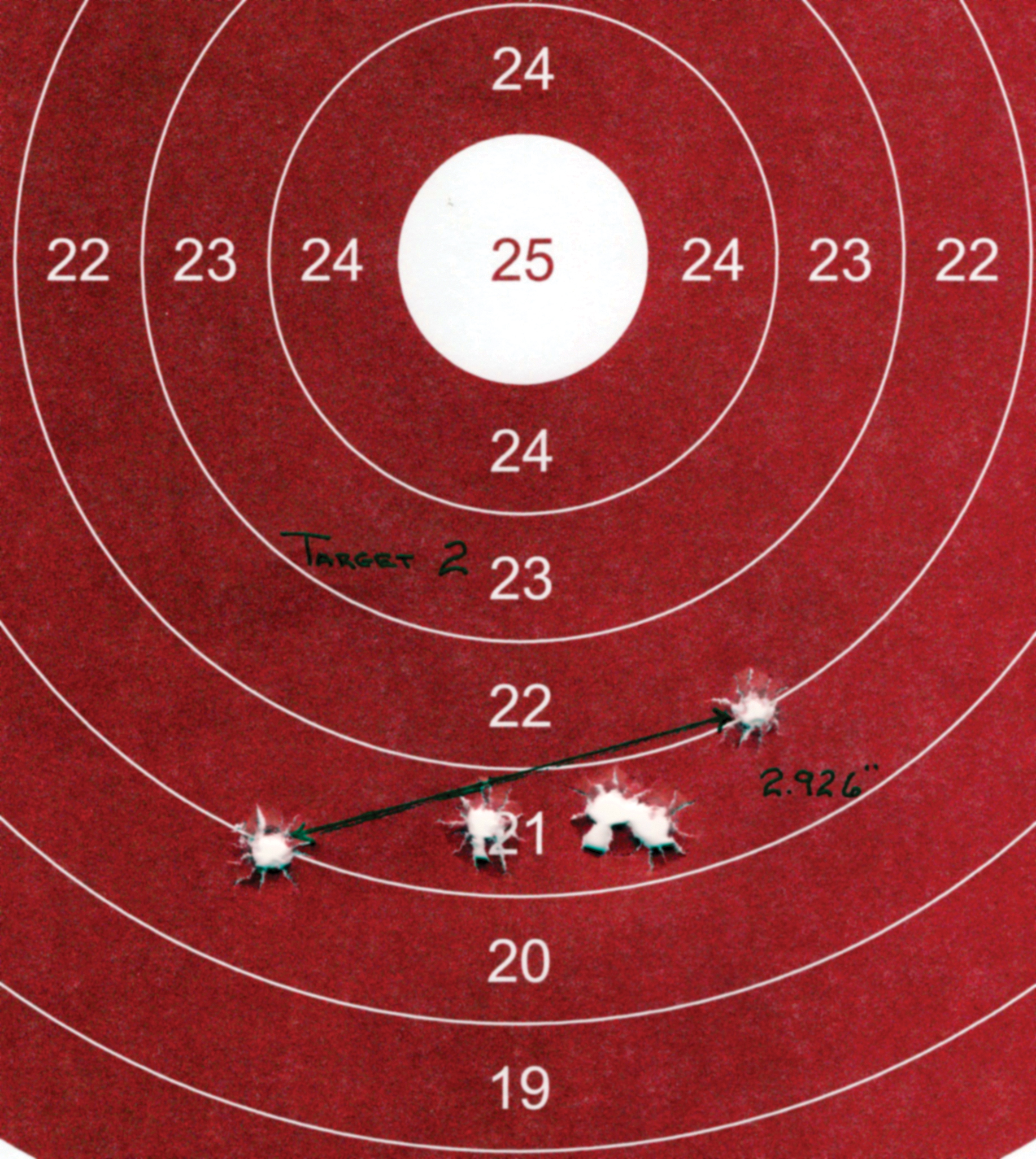
Target 2
When cleaning after the shooting session, I noted that barrel had not leaded at all and wiped out easily, using four patches to get it thoroughly clean. This shows a good interior finish that does not hang up lead or fouling, something which is very important to the rifleman who may be using the rifle in competition. The lube star at the muzzle was uniform and not canted, showing a square crown, and it did not pick up any fuzz from the cleaning patches. If a crown is rough, material from the cleaning patches will sometimes stick to the small burrs. Out of curiosity, I measured the I.D. of the fired cases and came up with .382. I think this is a good chamber for general work, not so tight to cause problems with feeding or bullet selection, but not oversize.
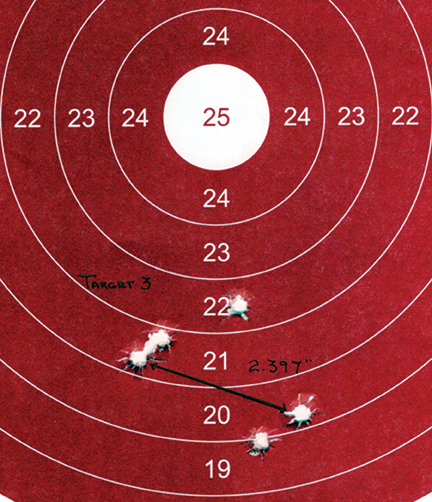
Target 3
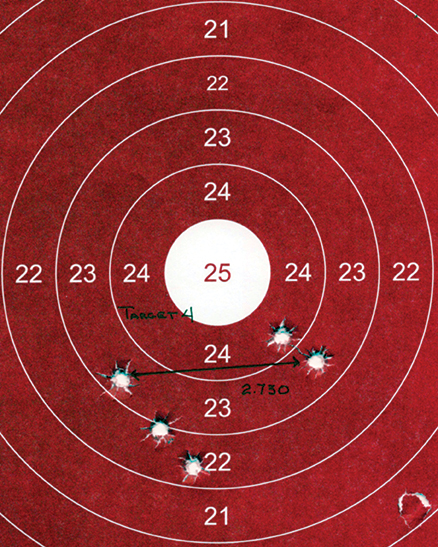
Target 4
I really like this Model 1894 rifle from Cimarron Arms. Fit and finish rivals the original Winchester production and it shoots as well as any 1894 I’ve owned (and I’ve owned a fair share.) I think it represents exceptional value for the money and for the shooter looking for a practical, good-looking rifle for competition or hunting, this copy of the trusty old ’94 makes a smart choice. The retail price for the Cimarron 1894 38-55 Short Rifle is $1,393.90, as of this writing.
If you think that one of these quality firearms needs to be in your rifle rack, contact Cimarron F.A. Co., 105 Winding Oak Road, Fredericksburg, TX 78624 or call them at 877-SIX-GUN1 (1-877-749- 4861). I highly recommend getting their catalog or taking a look at their website at cimarron-firearms.com, as they carry a large selection of handgun, rifles and shotguns for the Old West enthusiast. No doubt, you will see something else that you can’t live without. Personally, I’m hoping to soon see their 1894 Model offered in one of my favorite calibers, the 25-35 WCF.













